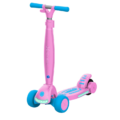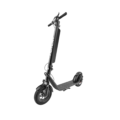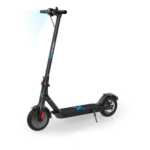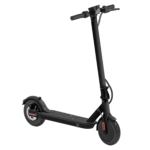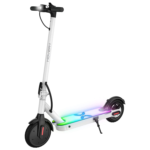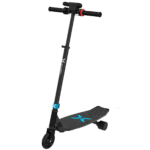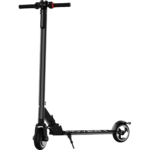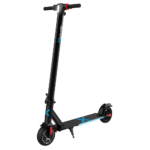- Home
- Scooters
- Electric Scooters
- Hover-1 Gambit
Hover-1 Gambit


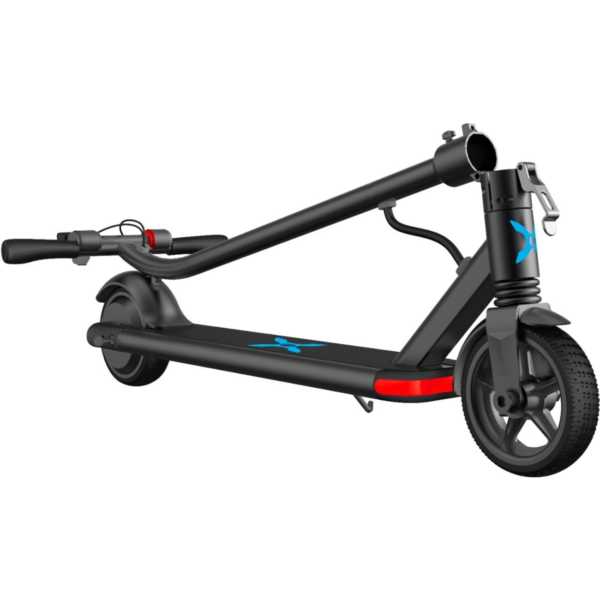
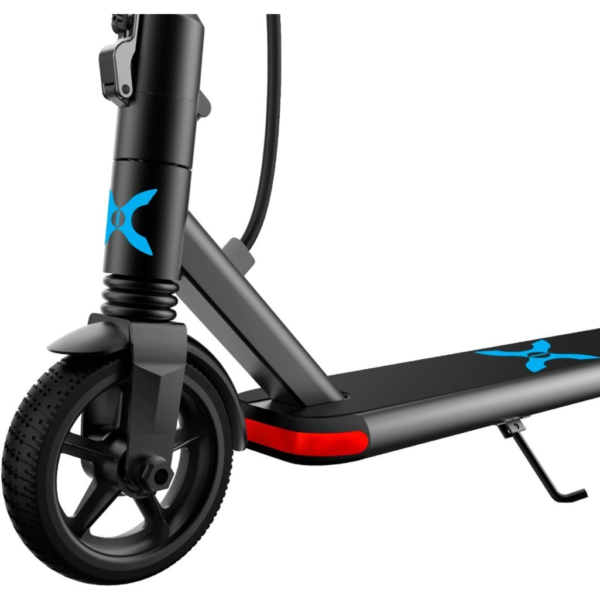
- Battery Range: 9 miles (14 km)
- Top Speed: 15 mph (24 km/h)
- Motor Power: 250 W
- Weight Capacity: 264 lb (120 kg)
- Charging Time: ~3 h
- Scooter Weight: Not specified
PROS
- 15 mph top speed with 250W motor
- Up to 9 miles per charge
- 6.5″ solid tires
- Electronic + foot braking
- Quick ~3 h charge time
- Folding design
CONS
- Short range
- Small wheels affect ride comfort
- No suspension
Table of contents
- What Is the Hover-1 Gambit?
- How the Hover-1 Gambit Works
- Key Specifications
- Design & Build Quality
- Performance Fundamentals
- Battery, Range & Efficiency
- Ride Quality & Comfort
- Braking & Safety Features
- Portability & Daily Usability
- Maintenance & Care
- Weather & Seasonal Considerations
- Hover-1 Gambit vs Alternatives
- Who the Hover-1 Gambit Is (and Isn’t) For
- FAQs
- Glossary
- Final Notes on Fit and Expectations
The Hover-1 Gambit is a compact, entry-level electric scooter built for short, predictable trips. It favors simplicity, low maintenance, and straightforward controls. Moreover, because it runs on small solid tires, it suits riders who value puncture-free reliability more than plush suspension. If you want an easy, portable way to cover a few miles at a steady pace, the Hover-1 Gambit fits the brief.
What Is the Hover-1 Gambit?
The Hover-1 Gambit is a lightweight, foldable e-scooter with a 250W brushless hub motor, a 36V lithium-ion battery, and basic electronic plus mechanical braking. Top speed is rated up to 15 mph (24 km/h), and the claimed single-charge range reaches 9 miles (15 km) in ideal conditions. In addition, it uses 6.5-inch solid tires front and rear, so there are no tubes to inflate or punctures to repair. An LCD readout sits at the cockpit and shows speed and battery bars. Furthermore, a built-in LED headlight helps with being seen, while the chassis keeps weight around 33 lb (15 kg), which makes carrying manageable for short distances.
In short, this is a simple commuter and campus scooter that trades long-range capability and high power for low fuss, easy storage, and an approachable ride.
How the Hover-1 Gambit Works
Motor. Think of the front wheel as a compact, self-contained engine. The 250W brushless hub motor sits inside the hub and spins the wheel directly. Because it has no belts or chains, it feels quiet and needs very little upkeep. Additionally, the design reduces routine alignment issues that belt drives sometimes introduce.
For a quick comparison of hub vs belt vs chain drive efficiency, noise, and maintenance, the Gambit’s direct-drive hub sits on the low-maintenance, low-noise end of the spectrum.
Controller. A small electronic “brain” meters power between the battery and motor. When you press the throttle, the controller sends current to the hub motor smoothly. It also manages the electronic brake, which reverses motor torque gently to slow the wheel. Consequently, you get predictable launches and steady deceleration without sudden surges.
Battery. A 36V, 5.2Ah lithium-ion pack sits inside the deck. That equals roughly 187Wh of energy. You charge it with the included brick through a 1-pin charge port until the indicator flips to green. As a result, a full charge typically takes up to 3 hours from low.
Throttle. On the right side, a thumb throttle lets you add speed. The Gambit requires a kick-to-start nudge before the motor engages. Therefore, accidental launches are less likely if you bump the throttle while standing still.
Brakes. You get two systems: the electronic brake you activate at the left lever (mild regen feel), and a mechanical rear fender brake you step on to add stopping force. Together, they provide predictable control at the Gambit’s modest top speed. Even so, you should practice combining both systems to shorten stops effectively.
Key Specifications
Below is a clean, block-by-block table so you can scan the essentials quickly. Units are provided in both imperial and metric where relevant.
General
| Item | Value |
|---|---|
| Model | H1-GAM (Hover-1 Gambit) |
| Recommended minimum rider age | 15+ years |
| Net weight | 33 lb (15 kg) |
| Max supported weight | 264 lb (120 kg) |
| Minimum supported weight | 44 lb (20 kg) |
| Water exposure | Water-resistant; not waterproof; avoid heavy rain/splashing |
Performance & Power
| Item | Value |
|---|---|
| Motor | 250W brushless hub (front wheel) |
| Top speed (rated) | Up to 15 mph (24 km/h) |
| Typical hill behavior | Short, moderate grades only; best on ~7–10% rises |
| Drive | Direct-drive hub (no chain/belt) |
Battery, Charging & Electrical
| Item | Value |
|---|---|
| Battery | 36V 5.2Ah lithium-ion (~187 Wh) |
| Claimed range | Up to 9 miles (15 km) |
| Charger | External AC adapter (included) |
| Charge time | Up to 3 hours to full |
| Operating temperature | 32–104°F (0–40°C) |
| Low-temperature note | Range drops as temps fall below 40°F (4°C) |
| Display | LCD speedometer with battery indicator |
| Lighting | Integrated LED headlight (no factory reflectors) |
Build & Dimensions
| Item | Value |
|---|---|
| Frame | Aluminum with folding column and latch |
| Tires | 6.5 in solid (front & rear) |
| Open size (L × W × H) | 45.3 × 18.1 × 39.4 in (115 × 46 × 100 cm) |
| Folded size (L × W × H) | 45.3 × 18.1 × 16.1 in (115 × 46 × 41 cm) |
| Kickstand | Side-mounted |
Safety & Control
| Item | Value |
|---|---|
| Brakes | Electronic (lever-actuated) + mechanical rear fender brake |
| Start behavior | Kick-to-start (safety) |
| Cockpit | LCD, throttle on right, e-brake lever on left |
| Visibility | LED headlight; wear reflective gear for night riding |
| IP rating | Not published; treat as splash-resistant only |
Features & Extras
| Item | Value |
|---|---|
| Folding mechanism | Column release lever with twist lock |
| Cruise Control | Not included |
| Tires | Puncture-proof solid design |
| App | Not required to ride |
Warranty & Compliance
| Item | Value |
|---|---|
| Warranty | 90-day limited parts & labor (manufacturer defects) |
| Local laws | Vary by region; check rules for e-scooter use |
(The tables above compile the official specifications where Hover-1 publishes them and present conversions for clarity.)
Design & Build Quality
For a budget scooter, the Hover-1 Gambit shows careful attention to simple, repeatable construction. The aluminum frame keeps weight reasonable while offering enough rigidity for everyday paved routes. Additionally, the deck is low and narrow, which helps stability at modest speeds and makes kick-starts natural. Because the tires are 6.5-inch solid, the fork, swing area, and deck edges can be compact without making room for tubes.
The cockpit is basic yet functional. The LCD is easy to glance at and stays readable in daylight. Moreover, the throttle paddle has a short throw, which gives an immediate response from the controller without feeling twitchy. On the left, the electronic brake lever keeps your index fingers busy while your right foot can still reach the mechanical fender brake. This split helps newer riders because you can “feather” electronic braking before you add more force with your rear foot. As a result, transitions from cruising to stopping feel calm and controlled.
Fit-and-finish is what you’d expect at this tier: stamped parts, straightforward welds, and a latch designed around reliability, not speed. Even so, the folding joint uses a release lever with a twist-to-lock collar, which resists accidental opening. After a few folds, the action becomes second nature. Ultimately, the package favors consistency over luxury, which is sensible in this class.
Performance Fundamentals
Acceleration feel. From a push-off, the Hover-1 Gambit picks up speed with a smooth, linear surge. The 250W hub motor doesn’t yank. Instead, it builds pace over a few wheel rotations and settles into a calm cruise. On level ground, most adults will reach 12–15 mph without drama. Furthermore, the controller’s mapping rewards steady thumb input, so small throttle changes lead to small speed changes.
Cruising stability. At neighborhood speeds, the short wheelbase and small solid tires keep steering light. The deck sits low, which lowers your center of gravity and helps straight-line composure. However, on very rough patches, the solid tires transmit bumps, so you’ll naturally back off slightly to keep the ride tidy. Likewise, entering turns with a little less speed reduces chatter and preserves traction.
Hill behavior. On 7–10% grades, the Gambit will climb if you carry momentum and keep your stance centered. Expect speed to taper; the motor is tuned for efficiency over brute force. Consequently, starting from a full stop on steeper rises is challenging, so plan a rolling approach and give it a strong manual kick. Meanwhile, keeping your weight forward helps the front hub maintain traction.
Battery, Range & Efficiency
The Gambit’s 36V, 5.2Ah battery (~187 Wh) is sized for short urban trips and campus hops. The rated up to 9 miles (15 km) assumes a light to average rider on flat ground, warm temperatures, and steady low-to-mid speeds. Real-world range depends on several factors:
- Rider weight. Heavier riders draw more current during starts and hills.
- Terrain. Frequent stops, hills, and rough surfaces eat more watt-hours per mile.
- Temperature. Lithium-ion packs deliver less energy in the cold; you’ll notice a drop below about 40°F (4°C).
- Speed habits. Holding near top speed increases wind drag and cuts range.
Practical planning. For mixed city riding with occasional grades, most adults should expect 4–7 miles (6–11 km) on a charge. If you keep speeds conservative and roads smooth, the upper end is achievable. Conversely, frequent stop-and-go on colder days pushes you toward the lower end. Therefore, planning a quick midday top-off can extend your useful loop.
Charging best practices. Use the included charger, avoid deep storage discharge, and let the pack rest a few minutes after rides before charging. If you won’t use the scooter for a few weeks, store it indoors, around room temperature, with the battery at roughly 40–60%. Additionally, check and top it off monthly. Because shallow cycles are gentler on lithium cells, brief charges during the week are perfectly reasonable.
Ride Quality & Comfort
Because the Hover-1 Gambit rides on 6.5-inch solid tires and has no suspension, it feels firm. On smooth asphalt or well-kept pathways, that firmness translates into a clean, connected ride. Over cracked sidewalks or coarse chip seal, you’ll feel the texture. However, the upside is zero flats, no pump, and minimal routine care.
Ergonomics. The deck length supports a staggered stance. Keep your front foot angled slightly and your rear foot across the fender for easy access to the mechanical brake. The stem height suits average adults; shorter riders can stand upright without hunching. There’s slight, normal stem flex under hard braking, but not enough to disturb control at this scooter’s speed ceiling. Moreover, keeping your arms relaxed reduces transmitted vibration.
Tire maintenance? None for pressure—another benefit of solid rubber. Just glance at the tread periodically for cuts or embedded debris and wipe away grit that can abrade the material. Similarly, check the fender alignment to ensure the mechanical brake contacts cleanly.
Braking & Safety Features
The Gambit uses two systems:
- Electronic brake (lever-actuated). It initiates gentle motor-based slowing in the hub. Bite is soft at lever tip, then builds gradually. It’s great for speed trimming and smooth stops from lower speeds. Additionally, using it first keeps the rear fender brake cooler and cleaner.
- Mechanical rear fender brake. Step on it to increase stopping force. On loose surfaces, apply smoothly to avoid a skid. With practice, the combination feels natural: start with the electronic brake and add foot pressure as needed. As a result, you get stable deceleration without harsh front-wheel weight shifts.
Lighting & visibility. There’s an LED headlight to help you be seen. The stock scooter does not come with reflectors. Therefore, ride with reflective clothing in low light and keep your speed down at dusk. Likewise, choose routes with better street lighting whenever possible.
Weather. The Gambit is water-resistant but not waterproof. Think light splashes only. Avoid puddles and heavy rain because water ingress can damage electronics and bearings. After any wet exposure, dry the scooter and store it indoors. Ultimately, moisture management is part of safe ownership.
Portability & Daily Usability
Weight and carry. At 33 lb (15 kg), the Hover-1 Gambit is manageable for short carries up stairs or onto a bus. It’s not “ultralight,” yet the balanced center of mass and secure latch make one-handed rolls practical. Moreover, the low folded profile simplifies hallway storage.
Folding. The release-and-twist latch closes the steering column with a positive lock. You’ll hear and feel it seat. Always double-check the twist collar before riding; it prevents joint rattle and adds confidence on bumpy paths. Meanwhile, practicing the fold a few times speeds up your routine at transit doors.
Storage & security. Because the folded height is about 16.1 in (41 cm), it slides under many desks or into a car trunk. Locking strategies vary by environment; a compact, high-quality lock through the frame and a fixed object discourages quick grabs. Do not leave the scooter stored outdoors for long periods; heat, cold, and moisture shorten component life. Consequently, indoor storage pays dividends in reliability.
Maintenance & Care
Fastener checks. Every couple of weeks, verify that the stem latch, handlebar ends, and brake components are snug. Light threadlocker on stem clamp screws is reasonable if you’ve noticed loosening. Additionally, wiping threads before reassembly helps threadlocker bond.
Brake care. Keep the fender brake clean. Grit and moisture reduce effectiveness. Because the electronic brake is wear-free, it’s smart to use it first and save the fender for final meters of stopping. As a result, pads and plastic surfaces last longer.
Firmware/app. The Gambit works without an app. That removes one more variable from maintenance. Nevertheless, you should still monitor hardware behavior; unusual noises often point to fasteners or bearings.
Cleaning. Wipe with a damp cloth. Avoid spraying water directly into the charge port, display, or hub area. Then dry after wet rides. Finally, apply a little silicone protectant on exposed rubber bits to keep them supple.
Simple schedule.
- Before each ride: Tire surface check, latch locked, charge at least two bars.
- Weekly: Latch screws, brake feel test, deck and fender inspection.
- Monthly: Battery top-off if stored, full visual inspection for cracks or deep scratches.
- Seasonally: Stem joint lubrication (light), comprehensive fastener check.
Weather & Seasonal Considerations
Rain. Treat the Hover-1 Gambit as splash-resistant only. If you’re caught in a drizzle, slow down, avoid puddles, and dry the scooter thoroughly after. Water can corrode connectors and shorten bearing life. Consequently, planning alternate routes or waiting out showers is wise.
Heat. In hot weather, allow the battery to cool for 10–15 minutes before charging. Store away from direct sun; a hot deck stresses cells and plastics. Furthermore, avoid leaving the folded scooter in a closed car on summer days.
Cold. Below 40°F (4°C), expect reduced range and a stiffer ride. Rubber hardens and traction falls, so leave extra stopping distance and take corners gently. Likewise, pre-warming the scooter indoors slightly improves early-ride performance.
Storage. Long-term storage indoors at moderate temperature keeps the battery healthy. If you won’t ride for several weeks, aim for 40–60% charge and top off monthly. Ultimately, consistent storage habits extend pack life.
Hover-1 Gambit vs Alternatives
Where the Gambit excels. It’s ideal for short urban routes, school campuses, and last-mile hops from transit to work. The 6.5-inch solid tires remove flat-related downtime, and the kick-to-start safety layer keeps new riders comfortable. If you value a light footprint, quick folds, and predictable controls, the Gambit punches above its class. Additionally, the straightforward drivetrain keeps upkeep minimal.
Compared to commuter-class scooters. Bigger commuter models add larger pneumatic tires, suspension, and bigger batteries. They ride softer and go farther, yet they’re heavier and cost more. If you routinely cover over 7 miles per charge or ride on broken pavement, a commuter-class option will feel nicer. Conversely, if your rides are short and storage is tight, the Gambit remains the practical choice.
Compared to performance models. High-power scooters bring dual motors, hydraulic brakes, and high-capacity packs. They’re dramatically faster, but also heavier, bulkier, and maintenance-intensive. The Gambit stays simple, legal-friendly at neighborhood speeds, and easy to store. Therefore, beginners often learn faster on the Gambit before moving up.
Compared to off-road styles. Off-road rigs use knobby tires and long-travel suspension. They handle dirt and grass, but all that hardware adds weight and complexity. For paved paths and daily errands, the Gambit’s lean design is the practical pick. Similarly, its modest power keeps traction predictable on smooth concrete.
Who the Hover-1 Gambit Is (and Isn’t) For
Great for:
- Students who shuttle between classes across a large campus.
- Multi-modal commuters who need a simple ride from train or bus to destination.
- Apartment dwellers who must fold and stash under a desk or in a small closet.
- Newer riders who want predictable controls and don’t want to manage tire pressure.
Not ideal for:
- Riders needing long range, steep hill performance, or high cruising speeds.
- Anyone frequently riding on rough or broken pavement.
- All-weather commuters who must ride in sustained rain.
Ultimately, aligning your needs with the Gambit’s strengths leads to a satisfying experience. If your daily loop is short and smooth, the trade-offs make sense.
FAQs
1) Is the Hover-1 Gambit good for daily commuting?
Yes—if your one-way trip lands within 3–4 miles (5–6 km) on mostly smooth surfaces. For longer routes or broken pavement, consider a larger-tire commuter scooter instead.
2) Can I ride the Gambit in light rain?
It is water-resistant, not waterproof. Light splashes happen, but you should avoid rain and puddles. Therefore, dry it carefully after any wet exposure.
3) How long does the battery last per charge?
The rated up to 9 miles (15 km) assumes light loads and warm weather. In mixed, real-world riding, plan for 4–7 miles (6–11 km). Consequently, colder temperatures reduce those figures.
4) Does the Gambit have regenerative braking?
It uses an electronic brake that adds mild motor-based slowing. Treat it as a smooth decelerator and combine it with the mechanical fender brake for shorter stops. As a result, you’ll balance control with wear reduction.
5) What tire maintenance is required?
None for pressure. The 6.5-inch solid tires don’t need air. Just keep the tread clean and inspect occasionally for cuts. Additionally, watch for debris stuck near the fender.
6) Is there Cruise Control on the Gambit?
No. The Hover-1 Gambit does not include Cruise Control. Instead, hold the throttle for steady cruising and relax your grip to manage speed.
7) Where can I find a concise Hover-1 Gambit overview?
You’re reading it. This article covers the essentials in one place, from hardware to care and daily use, so you can decide quickly.
Glossary
- Ah (amp-hours): Battery capacity. Higher Ah usually means more stored energy.
- Wh (watt-hours): Battery energy (voltage × amp-hours). A clearer measure of range potential.
- Brushless hub motor: A motor built into the wheel hub; quiet and low maintenance.
- Controller: The electronics that meter power between battery and motor.
- Regen (regenerative braking): Using the motor to slow the wheel and recover a bit of energy.
- Stem flex: Small bending of the vertical tube under load; slight flex is normal.
- Kick-to-start: You must push off before the throttle activates, for safety.
- Solid tire: Airless tire that can’t go flat; rides firmer than pneumatic.
- IP rating: Ingress Protection code for dust/water resistance. (Not published for Gambit.)
- Pneumatic tire: Air-filled tire; smoother ride, but requires pressure checks and can puncture.
- Deck: The platform you stand on.
- Fender brake: Rear fender that acts as a friction brake when pressed.
- Throttle: Lever or paddle that commands speed.
- UL/Compliance: Electrical safety certifications; manufacturers sometimes list them in manuals.
- One-pin charge port: Single-pin connector used with the included charger.
Final Notes on Fit and Expectations
The Hover-1 Gambit thrives when ridden within its design envelope. Keep speeds measured on imperfect surfaces, use both brakes in sequence, and plan routes that avoid long, steep hills. In return, you get a compact, easy e-scooter that folds fast, resists flats, and sips energy. Overall, for many short daily hops, that blend is exactly right.
This write-up mirrors the official specifications and then translates them into practical, test-style guidance. Consequently, you can set realistic expectations before your first ride and maintain the scooter with confidence afterward. Additionally, by following the care tips above, you’ll preserve performance for many commutes.
Specifications
General
| Model The Model specifies the exact version or name of the scooter. It helps identify its unique design, features, and specifications within the manufacturer’s product line. Knowing the model makes it easier to compare options, find compatible accessories, or look up support information. | Gambit |
| Brand The Brand identifies the manufacturer or company that designs and produces the scooter. A trusted brand is a sign of quality, reliability, and good customer support. Well-known brands often have higher standards for safety, performance, and after-sales service, giving you more confidence in your purchase. | Hover-1 |
| Release Date The Release Date indicates when the scooter model was officially launched on the market. This helps you know how current the design, technology, and features are. A newer release date often means updated components, improved performance, and the latest safety or smart features. | 17 November 2025 |
| Recommended Age Recommended Age indicates the minimum age range that the scooter is designed for, based on safety, size, and ease of use. Following the recommended age helps ensure that riders can handle the scooter’s speed, weight, and controls comfortably and safely. Always check local laws and use protective gear, especially for younger riders. | +16 |
Performance & Power
| Motor Power (Wattage) What it means: The motor power, measured in watts (W), shows how strong the scooter’s electric motor is. Why it matters: Higher wattage usually means better acceleration, more torque, and improved performance on hills or rough terrain. For example, a 250W motor is good for flat city roads and light riders, while a 500W or 1000W motor provides more power for faster speeds or climbing steep inclines. | 250 W brushless motor |
| Top Speed The Top Speed indicates the maximum speed that the scooter can reach under optimal conditions. It’s usually measured on level ground with a fully charged battery and an average rider weight. A higher top speed allows you to travel longer distances faster, but always ensure you ride within legal speed limits and your personal comfort zone for safety. | Up to 15 mph (24 km/h) |
| Battery Capacity Battery Capacity refers to the total amount of energy the scooter’s battery can store, usually measured in ampere-hours (Ah) or watt-hours (Wh). A higher battery capacity means you can ride longer distances on a single charge, reducing the need for frequent recharging. Keep in mind that actual range can vary depending on rider weight, terrain, speed, and weather conditions. | Not specified |
| Estimated Range per Charge The Estimated Range per Charge indicates the average distance the scooter can travel on a single full battery charge. This range is calculated under optimal conditions, such as flat terrain, moderate speed, and average rider weight. Real-world range may vary depending on riding style, terrain, weather, and load. A longer range means fewer recharges and greater freedom for longer trips. | Up to 9 miles (14 km) |
| Hill Climb Ability Hill Climb Ability describes the maximum incline or slope that the scooter can handle while maintaining stable performance. It’s typically expressed as a percentage or in degrees. A higher hill climb rating means the scooter can tackle steeper hills without losing too much speed or power. Actual climbing performance may vary based on rider weight, battery charge, and terrain conditions. | Up to 20° |
| Drive System The Drive System refers to how power from the motor is delivered to the wheels. Electric scooters typically use either a hub motor (directly integrated into the wheel) or a chain/belt drive system. A high-quality drive system ensures smooth acceleration, efficient power transfer, and low maintenance. The choice of drive system affects performance, noise level, and overall ride experience. | Not specified |
Charging & Electrical
| Charging Time Charging Time indicates how long it takes to fully recharge the scooter’s battery from empty to 100% using the standard charger provided. Faster charging means less downtime and more time on the road. Actual charging time may vary slightly depending on battery capacity, charger output, and environmental conditions. | Approx. 3 hours |
| Battery Type Battery Type refers to the specific technology used in the scooter’s battery, which affects performance, lifespan, weight, and charging time. Most modern electric scooters use high-quality lithium-ion (Li-ion) batteries because they offer a good balance of energy density, durability, and low maintenance. A reliable battery type ensures consistent power delivery and longer riding ranges. | Lithium-ion battery |
| Removable Battery A Removable Battery means the battery pack can be easily detached from the scooter for convenient charging and replacement. This feature allows you to charge the battery separately, swap it with a spare for extended range, or securely store it indoors in extreme weather. Removable batteries add flexibility and make it easier to keep your scooter powered up wherever you are. | Non-removable internal battery |
| Regenerative Braking Regenerative Braking is an energy-saving feature that converts some of the energy normally lost during braking back into battery power. When you slow down or brake, the motor works in reverse to generate electricity, which helps extend the scooter’s range and improves overall efficiency. This system also reduces wear on traditional brake components, leading to lower maintenance over time. | Yes (via electronic brake) |
| Lighting Lighting refers to the built-in front and rear lights that enhance visibility and safety when riding in low-light conditions or at night. Good lighting helps you see the road ahead and ensures that other road users can see you. Many scooters include LED headlights, taillights, and sometimes brake lights or side reflectors for added safety and compliance with local traffic regulations. | Not specified |
Build & Dimensions
| Scooter Weight Scooter Weight refers to the total weight of the scooter when fully assembled, including the battery. This affects how easy it is to carry, lift, and store the scooter when not in use. A lighter scooter is more portable and convenient for commuting, especially if you need to carry it upstairs or onto public transport. Keep in mind that a sturdy frame and quality components may add to the weight but also contribute to better durability and ride stability. | Not specified |
| Maximum Rider Weight Maximum Rider Weight indicates the highest rider weight that the scooter is designed to safely support while maintaining optimal performance and stability. Staying within this limit helps ensure reliable acceleration, braking, and climbing ability, and it protects the frame, suspension, and motor from excessive strain. Exceeding the recommended limit may reduce performance and increase wear on components. | 264 lb (120 kg) |
| Deck Size Deck Size refers to the dimensions of the scooter’s standing platform. A wider and longer deck provides more foot space, allowing you to stand comfortably and adjust your stance while riding. A well-sized deck improves balance and stability, especially on longer rides or at higher speeds. Compact decks, on the other hand, help keep the scooter lightweight and portable. | Not specified |
| Handlebar Height Handlebar Height refers to the distance from the deck to the handlebars, which affects your riding posture and comfort. An appropriate handlebar height helps you maintain good balance, reduces strain on your back and arms, and makes steering more comfortable. Some scooters have adjustable handlebars to fit riders of different heights, while others have a fixed height for a streamlined design. | Fixed |
| Folding Mechanism The Folding Mechanism describes how easily and securely the scooter can be folded for carrying and storage. A well-designed folding system lets you quickly collapse the scooter into a compact size, making it convenient to transport on public transit, store under a desk, or fit into a car trunk. Look for sturdy latches and safety locks to ensure the scooter stays firmly in place when folded or unfolded. | Folding latch |
| Dimensions Folded Dimensions indicate the size of the scooter when it’s fully folded. This measurement shows how much space the scooter will take up when stored or carried, making it easier to check if it will fit in your car trunk, under a desk, or in a closet. Compact folded dimensions are ideal for commuters who need to bring their scooter on public transport or store it in tight spaces. | Not specified |
| Material Material refers to the primary construction materials used for the scooter’s frame and key components. High-quality materials like aircraft-grade aluminum, reinforced steel, or durable composites provide strength, stability, and a lighter overall weight. A sturdy material ensures the scooter can handle daily wear and tear while maintaining safety and performance. | Not specified |
Safety & Control
| Brake Type(s) Brake Type(s) describe the braking systems the scooter uses to help you slow down or stop safely. Common brake types include mechanical brakes (like drum or disc brakes), electronic brakes, and foot brakes. Many scooters combine multiple braking systems for added safety and shorter stopping distances. The type and quality of brakes affect your control, especially when riding at higher speeds or on slopes. | Electronic brake + rear foot brake |
| Suspension Suspension refers to the system that absorbs shocks and vibrations while riding, providing a smoother and more comfortable ride over uneven or rough surfaces. Scooters may have front suspension, rear suspension, or dual suspension for better shock absorption and stability. Good suspension helps reduce rider fatigue and improves control, especially when riding on bumpy roads or off-road paths. | None |
| Tire Type Tire Type refers to the kind of tires the scooter uses, which directly affects ride comfort, traction, and maintenance. Common types include solid (airless) tires, pneumatic (air-filled) tires, or hybrid options. Pneumatic tires offer better shock absorption and a smoother ride on rough surfaces, while solid tires are puncture-proof and require less upkeep. The right tire type helps ensure safe handling and a comfortable ride in different conditions. | Solid tires |
| Tire Size Tire Size indicates the diameter and width of the scooter’s tires, which affect ride comfort, stability, and how well the scooter handles different terrains. Larger tires generally offer better shock absorption and a smoother ride over bumps and rough surfaces, while smaller tires keep the scooter lighter and more portable. Choosing the right tire size helps ensure a balance between agility and comfort. | 6.5-inch |
| Kickstand The Kickstand is a built-in stand that allows you to park your scooter upright when it’s not in use. A sturdy kickstand keeps the scooter stable and prevents it from tipping over, protecting it from scratches and damage. It also makes storing and accessing your scooter more convenient, whether you’re at home, work, or on the go. | Side kickstand |
| Water Resistance Rating Water Resistance Rating indicates how well the scooter is protected against water and moisture, usually shown as an IP (Ingress Protection) rating. This rating helps you understand whether the scooter can handle light rain, splashes, or wet roads without damage. While most scooters are not fully waterproof, a good water resistance rating adds peace of mind when riding in changing weather conditions. Always avoid deep puddles or submerging the scooter to protect its electrical components. | Not specified |
Features & Extras
| Display/Console The Display (or Console) shows important real-time information about your ride, helping you monitor your scooter’s status at a glance. Typical displays show speed, battery level, distance traveled, and riding mode. Some models also include additional features like Bluetooth connectivity, app integration, or backlighting for better visibility at night. A clear and easy-to-read display enhances safety and convenience on every trip. | Not specified |
| Ride Modes Ride Modes refer to the different speed and power settings you can choose to match your riding style or road conditions. Common modes include eco for maximum range and energy efficiency, standard for everyday balance, and sport or turbo for higher speed and stronger acceleration. Switching between ride modes allows you to customize performance, conserve battery, and ride safely in various environments. | Not specified |
| Smart App Connectivity Smart App Connectivity lets you pair your scooter with a dedicated mobile app via Bluetooth. Using the app, you can monitor real-time ride stats like speed, battery level, and range, adjust settings such as ride modes or cruise control, lock the scooter for added security, and sometimes receive firmware updates. This feature adds convenience and allows you to personalize your riding experience right from your smartphone. | No app |
| Anti-Theft System The Anti-Theft System helps protect your scooter from unauthorized use or theft. This feature can include built-in alarms, electronic motor locks, GPS tracking, or remote locking through a mobile app. A good anti-theft system provides peace of mind when parking your scooter in public spaces, adding an extra layer of security to safeguard your investment. | Not specified |
| Cruise Control Cruise Control allows you to maintain a steady speed without continuously holding the throttle. This feature makes longer rides more comfortable by reducing hand fatigue and providing a smoother, more relaxed riding experience — especially on flat, open roads or bike lanes. For safety, cruise control can usually be easily activated or deactivated while riding. | Not specified |
| Accessories Included Accessories Included lists the additional items that come with the scooter to enhance your riding experience and convenience. Common accessories may include a charger, kickstand, bell, lights, phone holder, or carrying strap. These extras add value by making your scooter safer, easier to use, and ready to ride straight out of the box. | Scooter, charger, manual |
Warranty & Compliance
| Warranty Period The Warranty Period indicates how long the manufacturer guarantees the scooter against defects in materials and workmanship under normal use. A good warranty provides peace of mind, showing the brand’s confidence in its product quality. Always check what parts are covered, such as the frame, battery, and motor, and follow the maintenance guidelines to keep your warranty valid. | 90-day limited warranty (manufacturer defects) |
| Certifications Certifications confirm that the scooter meets specific safety, quality, and environmental standards set by recognized organizations or regulatory bodies. Common certifications may include CE, RoHS, UL, or other local compliance marks, depending on your region. These certifications ensure that the scooter is manufactured to high standards and is safe and legal to use in your country. | Region-dependent compliance |



